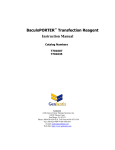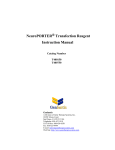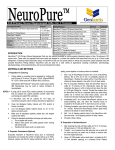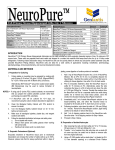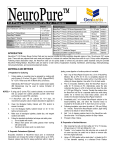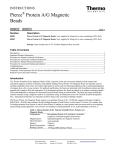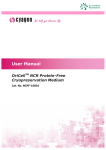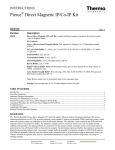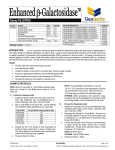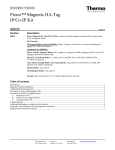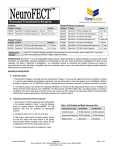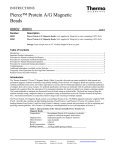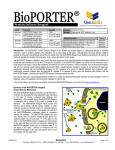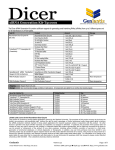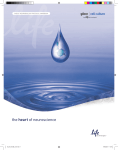Download Transfection Reagent
Transcript
® Transfection Reagent Catalog # T400101S T400150 (75-300 rxns.) T400750 (375-1,500 rxns.) A division of Gene Therapy Systems, Inc. Content NeuroPORTER Transfection Reagent, Trial Size DNA Diluent NeuroPORTER ® Transfection Reagent, Dried Lipid Film Hydration Buffer DNA Diluent NeuroPORTER ® Transfection Reagent, Dried Lipid Film Hydration Buffer DNA Diluent RELATED PRODUCTS Amount 0.2 ml GenePORTER® 3000 Transfection Reagent 1.0 ml 1 vial GenePORTER® Gold Transfection Reagent 1.5 ml 7.5 ml 5 vials GenePORTER® 2 Transfection Reagent GeneSilencer® siRNA Transfection Reagent BioPORTER® Protein Delivery Reagent 5 x 1.5 ml 5 x 7.5 ml NeuroFect™ Transfection Reagent Shipping Storage Shipped at room temperature Store kit at 4°C. MycoScope™ PCR Mycoplasma Detection Kit Catalog Numbers T203007, 0.75 ml (107 reactions) T203015, 1.5 ml (214 reactions) T203115, 1.5 ml (2,140 reactions) T204015, 1.5 ml (400 reactions) T204030, 2 x 1.5 ml (800 reactions) T204115, 15 ml (4,000 reactions) T202007, 0.75 ml (75 reactions.) T202015, 1.5 ml (150 reactions.) T202075, 5 x 1.5 ml (750 reactions.) T500750, 0.75 ml (200 reactions.) T505750, 5 x 0.75 ml (1,000 reactions) BP502424, 24 single use tubes. BP509696, 96 single use tubes. T800075, 0.75 ml (75-300 reactions.) T800750, 5 x 0.75 ml (375-1500 rxns.) MY01050 (50 reactions) MY01100 (100 reactions)) Introduction: NeuroPORTER® Transfection Reagent is a novel cationic lipid specially formulated for optimal transfection in neuronal cells, including primary neurons, differentiated post-mitotic neurons, neuronal cell lines, and glial cells. NeuroPORTER® Transfection Reagent is much easier to use than the traditional viral delivery method for transfecting DNA into neuronal cells. NeuroPORTER® Transfection Reagent is compatible with serum eliminates the need to change media following transfection. An included DNA Diluent is designed to facilitate DNA/lipid complex (lipoplex) formation and enhance the transformation efficiency in certain neuronal cells such as NT2 (not recommended for primary and differentiated neurons). Compared to other commercially-available transfection reagents, NeuroPORTER® provides superior transfection efficiency and minimized cytotoxicity. Cell type specific protocols are developed for NeuroPORTER® Transfection Reagents to ensure optimal transfection results. Methods and Procedures 1. Transfection of Primary Rat Hippocampal Neurons 1.1. Seed primary rat hippocampal cells in poly-D-lysine coated plates (Becton Dickinson Labware) in the numbers listed in Table 1 below using the following Plating Medium: Neurobasal medium (Invitrogen Cat. No. 21103-049) supplemented with B27, 0.5 mM L-glutamine and 25 µM glutamate. Incubate the cells at 37ºC in 5% CO2 for 72 hours. Table 1: Suggested Cell Plating Numbers. Culture Vessel 96-well 24-well 12-well 6-well 1.2. Cell Number (per well) 15,000 100,000 200,000 500,000 Plating Medium Volume 0.125 ml 0.5 ml 1.0 ml 2.0 ml 1.4. Dilute the DNA and hydrated NeuroPORTER reagent with serum-free medium. (do not use the DNA Diluent for primary neurons) Refer to Tables 2 and 3 for recommended DNA, NeuroPORTER, and serum-free medium volumes for different tissue culture plates. Table 2: Volumes of Transfection Reagents. DNA (µg) After 72 hours of incubation, remove ½ volume of the Plating Medium and replace with the following Culture Medium: Neurobasal medium supplemented B27 and 0.5 mM L-glutamine (no 25 µM glutamate). Continue incubation for an additional 24 hours. VKM110906 1.3. Hydrate the NeuroPORTER lipid vial at room temperature with 1.5 ml of the hydration buffer. Vortex for 30-60 seconds at top speed. Store the hydrated reagent at 4ºC and vortex briefly before use. Page 1 of 6 0.1 – 0.5 1.0 – 3.0 2.0 – 4.0 4.0 – 6.0 Serum Free Medium for DNA (µl) NeuroPORTER (µl) 12.5 25.0 37.5 62.5 2.5 5.0 7.5 12.5 Serum Free Medium For NeuroPORTER (µl) 10.0 20.0 30.0 50.0 1.5. Add the DNA solution to the diluted NeuroPORTER Transfection Reagent. Mix by pipetting up and down several times. Incubate at room temperature for 10 minutes to allow the NeuroPORTER /DNA complexes to form. Do not incubate for longer than 30 minutes. Table 3: Medium Volumes and DNA Amount for Various Culture Dishes. Culture Vessel DNA (µg) Serum Free Medium Volume (ml) Total Transfection Volume (ml) 96-well 0.1-0.5 0.1 0.125 24-well 1.0-3.0 0.45 0.5 12-well 2.0-4.0 0.925 1.0 6-well 4.0-6.0 1.375 1.5 1.6. Remove the Plating Medium from the cells, and add the volume of serum-free medium indicated in Table 3 to each well. 1.7. Apply the DNA/NeuroPORTER complexes from step 1.5 to each well. The total transfection volume at this step is indicated in Table 3. 1.8. Gently mix the DNA/NeuroPORTER/serum-free medium by swirling, and place the cells in a 37ºC incubator with 5% CO2. 1.9. After two hours of incubation, add one additional volume of fresh Culture Medium containing 2X concentration of B27 onto the cells. 1.10. Perform assay for gene expression after 24-48 hours. 2. Transfection of Other Primary Neurons 2.1. Hydrate the NeuroPORTER lipid vial at room temperature with 1.5 ml of the hydration buffer. Vortex for 30-60 seconds at top speed. Store the hydrated reagent at 4ºC and vortex briefly before use. 2.2. Dilute the hydrated NeuroPORTER reagent with serumfree medium. Refer to Table 4 for the appropriate volume of serum-free medium Table 4: Volumes of Transfection Reagents. DNA (µg) 0.5 1.0 2.0 4.0 6.0 8.0 VKM110906 Serum Free Medium for DNA (µl) 12.5 20.0 40.0 55.0 70.0 110.0 NeuroPORTER (µl) 2.5 5.0 10.0 20.0 30.0 40.0 Serum Free Medium for NeuroPORTER (µl) 10.0 15.0 30.0 35.0 40.0 70.0 Page 2 of 6 NOTE: Although NeuroPORTER has been optimized for specific cell culture conditions, optimization may be needed to achieve maximum transfection efficiency. The two critical variables are the ratio of NeuroPORTER reagent to DNA and the quantity of DNA used. For optimization of the ratio of NeuroPORTER reagent to DNA start by using 2.5 to 15 µl of reagent for each 1 µg of DNA. Use a fixed amount of DNA or vary the amount as suggested in the Appendix to optimize this ratio. 2.3. Dilute the DNA with the serum free medium (do not use the DNA Diluent for primary neurons). Refer to Table 4 for the appropriate volume of serum-free medium. NOTE: To obtain maximum efficiency in particular cells, some optimization may be needed. The two critical variables are the ratio of NeuroPORTER reagent to DNA and the quantity of DNA used. For optimization of the DNA quantity used, maintain a fixed ratio of NeuroPORTER reagent to DNA, and then vary the DNA quantity over a suggested range (see Table 5). See the Appendix for examples. 2.4. Add the DNA solution to the diluted NeuroPORTER Transfection Reagent. Incubate at room temperature for 5 to 10 minutes to allow the NeuroPORTER /DNA complexes to form. NOTE: Do not incubate the DNA solution with the NeuroPORTER Transfection Reagent for longer than 30 minutes 2.5. Add your complexes directly to the cells growing in serumcontaining culture medium. Refer to Table 5 for suggested medium volumes. Table 5: Medium Volumes and DNA Amount for Various Culture Dishes. Culture Vessel DNA (µg) Plating Medium Volume (ml) 96-well 0.1-0.5 0.2 24-well 0.5-3.0 0.5 12-well 1.0-4.0 1.0 6-well 2.0-6.0 1.5 60 mm 6.0-8.0 2.5 100 mm 8.0-12.0 5.0 2.6. Add fresh growth media as needed 24 hours post transfection. Depending on the cell type and promoter activity, the assay for the reporter gene can be performed 24 to72 hours following transfection. NOTE: For some cell types, the old media can be replaced with fresh media at this step. 3. Transfection of Neuronal Cell Lines 3.1. Hydrate NeuroPORTER lipid film at room temperature with 1.5 ml of the hydration buffer. Vortex for 30-60 seconds at top speed. Store the hydrated reagent at 4ºC and vortex briefly before use. 3.2. Dilute the hydrated NeuroPORTER reagent with serumfree medium. Refer to Table 6 for the appropriate volume of serum-free medium. Table 7: Suggested Cell Culture Conditions for Transfection of Neuronal Cell Lines. Culture Vessel 96-well 24-well 12-well 6-well 60 mm 100 mm Number of Cells / Well 25.0-30.0 x 103 125.0-150.0 x 103 250.0-300.0 x 103 500.0-600.0 x 103 1.0-1.5 x 106 2.5-3.0 x 106 Table 6: Volumes of Transfection Reagents. DNA (µg) DNA Diluent (µl) 0.5 1.0 2.0 4.0 6.25 12.5 25.0 50.0 NeuroPORTER (µl) 1.25 2.5 5.0 10.0 Serum Free Medium for NeuroPORTER (µl) 5.0 10.0 20.0 40.0 3.3. Dilute the DNA with the DNA Diluent and incubate 1 to 5 minutes at room temperature. Refer to Table 6 for the appropriate volume of DNA Diluent. Do not incubate DNA with the DNA Diluent for longer than 5 minutes. Avoid vortexing the DNA diluent. NOTE: Although NeuroPORTER consistently delivers high transfection efficiencies, in order to obtain maximum efficiency in particular cell types, some optimization may be needed. The two critical variables are the ratio of NeuroPORTER reagent to DNA and the quantity of DNA used. For optimization, first maintain a fixed ratio of NeuroPORTER reagent to DNA, and then vary the DNA quantity over the suggested range. If necessary, optimize the ratio of NeuroPORTER reagent to DNA by using 1.25 to 12.5 l of reagent for each 1 g of DNA. Use a low DNA quantity to optimize this ratio. Following this process, cell number can also be optimized. See the Appendix for examples. 3.4. Add the DNA solution to the diluted NeuroPORTER Transfection Reagent. Incubate at room temperature for 5 to 10 minutes to allow the NeuroPORTER /DNA complexes to form. Do not incubate the DNA solution with the NeuroPORTER Transfection Reagent for longer than 30 minutes. 3.5. Add your complexes directly to the cells growing in serumcontaining culture medium. Refer to Table 7 for suggested cell numbers for specific tissue culture dishes. Refer to Table 8 for appropriate medium volumes. NOTE: Cells plated the day before transfection should be 50% to 70% confluent on the day of transfection VKM110906 Page 3 of 6 Table 8: Medium Volumes and DNA Amount for Various Culture Dishes. Culture Vessel 96-well 24-well 12-well 6-well 60 mm 100 mm DNA (µg) 0.1-0.5 0.5-3 1.0-4.0 2.0-6.0 6.0-8.0 8.0-12.0 Medium Volume (ml) 0.2 0.5 1.0 1.5 2.5 5.0 3.6. Add fresh growth media as needed 24 hours post transfection. Depending on the cell type and promoter activity, the assay for the reporter gene can be performed 24 to72 hours following transfection. NOTES: For some cell types, the old media can be replaced with fresh media at this step. The same protocol can be used to produce stably transfected cells: 48 to 72 hours post transfection, put the cells in fresh medium containing the appropriate selection antibiotic. It is important to wait at least 48 hours before exposing the transfected cells to the selection media. For some cell types it may be necessary to wait as long as 4 to 5 days before applying the selection condition. 4. Transfection of Differentiated Post-Mitotic Neurons and Glial Cell Lines 4.1. Hydrate NeuroPORTER lipid film at room temperature with 1.5 ml of the hydration buffer. Vortex for 30-60 seconds at top speed. Store the hydrated reagent at 4ºC and vortex briefly before use. 4.2. Dilute the hydrated NeuroPORTER reagent with serumfree medium. Refer to Table 9 for the appropriate volume of serum-free medium. Table 9: Volumes of Transfection Reagents. DNA (µg) Serum Free Medium for DNA (µl) NeuroPORTER (µl) Serum Free Medium For NeuroPORTER (µl) 0.5 1.0 2.0 4.0 6.0 8.0 15.0 25.0 50.0 75.0 100.0 150.0 5.0 10.0 20.0 40.0 60.0 80.0 10.0 15.0 30.0 35.0 40.0 70.0 4.3. Dilute the DNA with the serum free medium. Refer to Table 9 for the appropriate volume of serum-free medium. NOTE: Although NeuroPORTER consistently delivers high transfection efficiencies, in order to obtain maximum efficiency in particular cell types, some optimization may be needed. The two critical variables are the ratio of NeuroPORTER reagent to DNA and the quantity of DNA used. For optimization, first maintain a fixed ratio of NeuroPORTER reagent to DNA, and then vary the DNA quantity over the suggested range. If necessary, optimize the ratio of NeuroPORTER reagent to DNA by using 5 to 20 µl of reagent for each 1 µg of DNA. Use a low DNA quantity to optimize this ratio. Following this process, cell numbers can also be optimized. See the Appendix for examples. Table 11: Medium Volumes and DNA Amount for Various Culture Dishes. Culture Vessel 96-well 24-well 12-well 6-well 60 mm 100 mm DNA (µg) 0.1-0.5 0.5-3.0 1.0-4.0 2.0-6.0 6.0-8.0 8.0-12.0 Medium Volume (ml) 0.2 0.5 1.0 1.5 2.5 5.0 4.6. 24 hours post transfection, add fresh growth media as needed. Depending on the cell type and promoter activity, the assay for the reporter gene can be performed 24 to72 hours following transfection. NOTE: For some cell types, the old media can be replaced with fresh media at this step. Also, the same protocol can be used to produce stably transfected cells: 48 to 72 hours post transfection, put the cells in fresh medium containing the appropriate selection antibiotic. It is important to wait at least 48 hours before exposing the transfected cells to the selection media. For some cell types it may be necessary to wait as long as 4 to 5 days before applying the selection condition. 4.4. Add the DNA solution to the diluted NeuroPORTER Transfection Reagent. Incubate at room temperature for 5 to 10 minutes to allow the NeuroPORTER /DNA complexes to form. Do not incubate the DNA solution with the NeuroPORTER Transfection Reagent for longer than 30 minutes. 4.5. Add your complexes directly to the cells growing in serumcontaining culture medium. Refer to Table 10 for suggested cell number according to culture dishes size and cell types. Refer to Table 11 for appropriate medium volumes. Cells plated the day before transfection should be 50% to 70% confluent on the day of transfection. Table 10: Suggested Cell Culture Conditions for Transfection of Differentiated Neurons and Glial Cells. VKM110906 Culture Vessel Cells / Well Diff. Neurons Cells / Well Glial Cells 96-well 35 x 103 50 x 103 24-well 150 x 103 200 x 103 12-well 300 x 103 400 x 103 6-well 600 x 103 800 x 103 60 mm 1.5 x 106 2 x 106 100 mm 3 x 106 4 x 106 Page 4 of 6 LIMITED LICENSE: The purchase price paid for the NeuroPORTER™ Transfection Reagent Kit (hereto “NeuroPORTER”) grants end users a non-transferable, non-exclusive license to use the kit and/or its components for internal research use only as described in this manual; in particular, research use only excludes and without limitation, resale, repackaging, or use for the making or selling of any commercial product or service without the written approval of Genlantis, a division of Gene Therapy Systems, Inc. (GTS) -- separate licenses are available for non-research use or applications. NeuroPORTER and/or its components are not to be used for human diagnostic or included/used in any drug intended for human use. Care and attention should be exercised in handling the kit components by following appropriate research laboratory practices and kit instructions. Purchasers may refuse this license by returning the enclosed materials unused. By keeping or using this kit, you agree to be bound by the terms of this license as governed and enforced by the laws of the State of California. APPENDIX – Transfection Optimization Examples I. Optimization conditions for primary neuron transfection in 24-well plates DNA /Well (µg) Follow the general protocol to prepare the DNA/NeuroPORTER complexes. We do not recommend using the DNA Diluent for primary neurons. Setup DNA dilutions in SFM* 1 2 3 10 µg in 250 µl 4 5 6 NeuroPORTER dilutions in SFM* 25 µl in 225 µl 50 µl in 200 µl 75 µl in 175µl 100 µl in 150 µl 125 µl in 125 µl 150 µl in 100 µl Total Volume 500 µl Final DNA Concentration III. Add the appropriate volume of complexes solution directly to your cells as illustrated below. DNA /Well (µg) 0.5 25.0 µl 1.0 50.0µl 2.0 100.0 µl 3.0 150.0 µl 0.5 12.5 µl 1.0 25.0µl 2.0 50.0 µl 3.0 75.0 µl Setup 1 2 3 4 5 6 20 µg/ml *SFM = Serum-free medium DNA/NP Complex Vol. Transfer/ Well DNA/NP Complex Vol. Transfer/ Well Optimization conditions for differentiated post-mitotic neurons and glial cell line transfection in 24-well plates Follow the general protocol to prepare the DNA/NeuroPORTER complexes. We do not recommend using the DNA Diluent for differentiated post-mitotic neurons and glial cells. Setup 1 2 3 4 5 6 Setup DNA dilutions NeuroPORTER in SFM* dilutions in SFM* 1 50 µl in 200 µl 2 75 µl in 175µl 3 100 µl in 150 µl 10 µg in 250 µl 4 125 µl in 125 µl 5 150 µl in 100 µl 6 200 µl in 50 µl Total Volume Final DNA Concentration 500 µl 20 µg/ml Add the appropriate volume of complexes solution directly to your cells as illustrated below. II. Optimization conditions for neuronal cell line transfection in 24-well plates Follow the general protocol to prepare the DNA/NeuroPORTER complexes. We recommend using the DNA Diluent for neuronal cell lines such as NT2. Setup DNA dilutions NeuroPORTER in SFM* dilutions in SFM* 1 12.5 µl in 112.5 µl 2 25 µl in 100 µl 3 50 µl in 75µl 10 µg in 125 µl 4 75 µl in 50 µl 5 100 µl in 25 µl 6 125 µl NP Only Total Volume 250 µl Final DNA Concentration 0.5 25.0 µl 1.0 50.0µl 2.0 100.0 µl 3.0 150.0 µl Setup 1 2 3 4 5 6 40 µg/ml Quality Control *SFM = Serum-free medium Add the appropriate volume of complexes solution directly to your cells as illustrated below. VKM110906 DNA /Well (µg) DNA/NP Complex Vol. Transfer/ Well Page 5 of 6 To assure the performance of each lot of the NeuroPORTER reagent, we pre-qualify the chemical synthesis of NeuroPORTER lipid by mass spectrometry and thin layer chromatography. The final product is further tested by in vitro β-galactosidase transfection assay in NT2 neuronal precursor cell. Each lot shall have an acceptance specification of >70% of the activity of the Reference lot. VKM110906 Page 6 of 6






